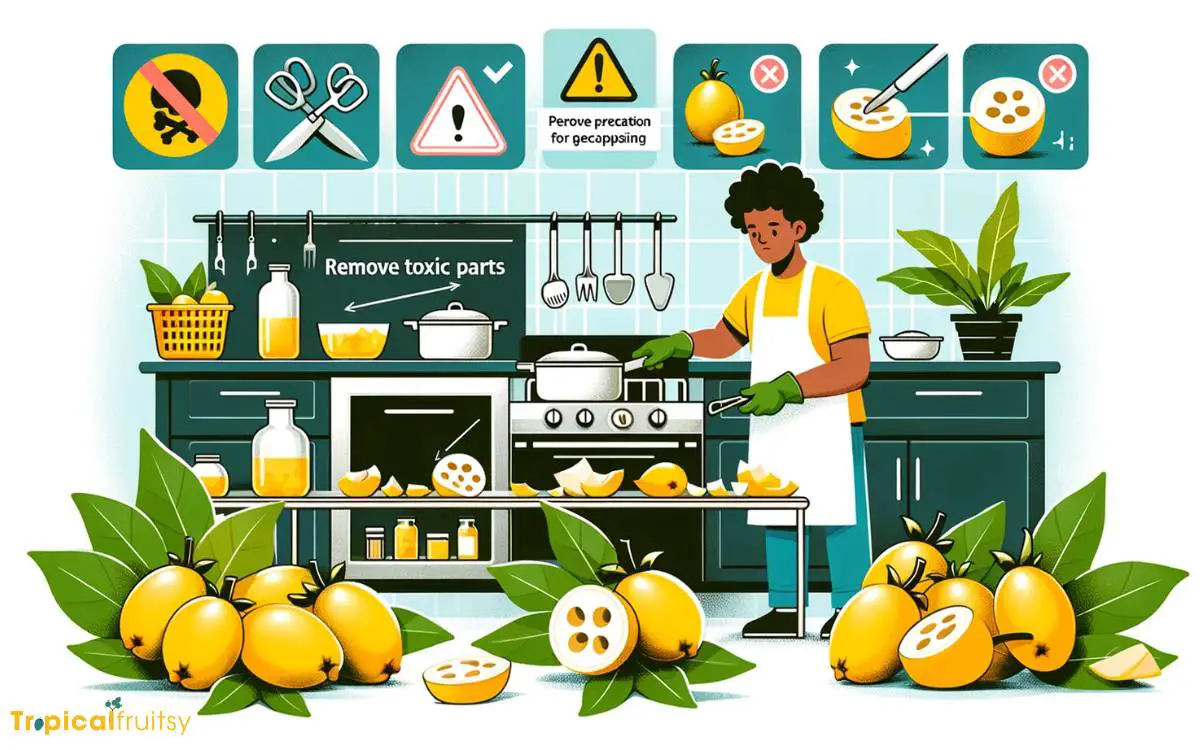Can I Eat Ackee While Breastfeeding? Nourishing Your Baby!
While breastfeeding, it is generally safe to consume ackee as long as it is fully ripe and properly prepared.
Ackee contains nutrients like essential fatty acids, vitamin A, and zinc, which can be beneficial during lactation. However, unripe ackee contains hypoglycin A, a toxin that can be dangerous.
Therefore, nursing mothers should only eat ackee that has been confirmed to be ripe and prepared by someone knowledgeable about the proper preparation methods to avoid any health risks to themselves or their baby.
Ackee must be eaten with caution due to the risk of hypoglycin A toxicity. Only the yellow arilli of fully ripe ackee should be consumed, and the fruit must open naturally on the tree.
Eating unripe or improperly prepared ackee can lead to Jamaican Vomiting Sickness, which can be especially dangerous for breastfeeding mothers and their infants.
To minimize risks:
Ensure safe consumption of ackee during breastfeeding by choosing only ripe, properly prepared fruit.

Key Takeaway
Key Factors in the Safe Preparation and Consumption of Ackee
| Factor | Description | Importance |
|---|---|---|
| Ripeness | Ackee must be fully ripe, indicated by the fruit naturally splitting open. | Crucial for safety |
| Preparation | Proper removal of toxic seeds and red fibers is necessary. | Essential to prevent toxicity |
| Cooking | Adequate cooking of the edible portions is required. | Important for reducing toxin levels |
| Knowledge | Preparation by individuals knowledgeable about ackee is recommended. | Ensures safety and proper handling |
| Nutritional Benefits | Provides essential fatty acids, vitamin A, and zinc. | Beneficial for lactation |
Understanding Ackee: Nutritional Value

Ackee, when safely prepared, is packed with essential nutrients such as protein, vitamins, and fatty acids that can be beneficial for lactating mothers.
This unique fruit, native to West Africa and popular in Caribbean cuisine, particularly Jamaica, contains a wealth of nutrients that can support both maternal health and breast milk quality.
Ackee is a good source of dietary fiber, which can aid in digestion and help maintain regular bowel movements, a common concern for postpartum women.
It also provides vitamin C, known for its role in immune function, and vitamin A, important for maintaining healthy skin and vision.
The presence of unsaturated fatty acids in ackee contributes to the development of the infant’s brain and nervous system.
However, it is crucial to consume ackee that has been properly ripened and cooked to eliminate potential toxins.
Ackee Preparation and Safety

While ackee is rich in nutrients, it is imperative that lactating mothers only consume the fruit after it has been properly ripened and thoroughly cooked, to neutralize any naturally occurring toxins.
Unripe ackee contains hypoglycin A, a toxin that can cause severe illness or even be fatal. To ensure safety, only the yellow, arilli portions of fully opened ackee fruits should be consumed.
These parts must be adequately boiled, and the water discarded to remove any remaining toxins. It is also advisable to purchase canned ackee, which is pre-cooked and subject to food safety regulations, making it a safer option for breastfeeding mothers.
Understanding these precautions can help mothers enjoy ackee without compromising their health or that of their infant.
Benefits of Ackee in Lactation

How does the consumption of properly prepared ackee benefit lactating mothers?
Ackee, when safely ripe and correctly cooked, can be a nutritious addition to the diet of breastfeeding mothers.
It provides several health advantages that are particularly beneficial during lactation:
- Rich in dietary fiber, which aids digestion and can help prevent constipation, a common issue during postpartum.
- High in essential fatty acids, supporting the development of the infant’s brain and nervous system.
- Contains vitamin C, important for the immune system and enhancing iron absorption.
- Good source of protein, crucial for repairing and building body tissues.
- Provides folate, which is necessary for DNA synthesis and can support maternal and infant health.
As we consider these benefits, it is equally important to weigh the potential risks for breastfeeding moms in the following section.
Potential Risks for Breastfeeding Moms

Although ackee can offer nutritional benefits when properly prepared, breastfeeding mothers should be aware of the potential risks associated with its consumption, such as the presence of harmful hypoglycin A if the fruit is unripe or improperly cooked.
This toxin can lead to severe vomiting, known as Jamaican Vomiting Sickness, and may have detrimental effects on both mother and child if transmitted through breast milk.
The table below summarizes the key concerns:
| Risk Factor | Description |
|---|---|
| Hypoglycin A Toxicity | Can cause severe vomiting and hypoglycemia if ackee is unripe or raw. |
| Contamination Risk | Improper handling may introduce foodborne pathogens. |
| Nutrient Transfer to Infant | Toxins present in ackee may pass to the infant through breast milk. |
| Dietary Caution | Breastfeeding mothers are advised to avoid or limit ackee to prevent risks. |
It is essential for breastfeeding mothers to prioritize safety and consult healthcare providers before including ackee in their diet.
Is Ackee Safe to Eat While Breastfeeding?
While breastfeeding, it’s important to consider the safety of the foods you consume. It is generally safe to eat ackee while breastfeeding, as long as it is prepared properly and consumed in moderation. However, if you are following a keto diet, you may want to limit your intake of ackee due to its higher carb content.
Expert Recommendations for Nursing Mothers

In light of the potential hazards, healthcare professionals commonly advise nursing mothers to exercise caution when considering the inclusion of ackee in their diet.
They recommend:
- Ensuring that ackee is fully ripe and properly prepared to mitigate the risk of toxicity.
- Consulting with a healthcare provider before introducing ackee or other exotic fruits into their diet.
- Observing the baby for any signs of adverse reactions whenever introducing new foods.
- Maintaining a varied and balanced diet to support both maternal and infant health.
- Being informed about the nutritional content and potential risks of all foods consumed during breastfeeding.
This guidance is grounded in an understanding of the unique nutritional needs and safety considerations for both mother and child during this critical period.
Conclusion
Acknowledging the allure of ackee’s attributes, it is imperative that lactating individuals heed health guidelines to harness its benefits while halting potential hazards.
Proper preparation paired with professional advice paves the path for partaking in this nutritious fruit, promoting the prosperity of both mother and child.
As studies suggest, safe consumption of ackee can contribute to a wholesome diet, fostering the flourishing of familial health in the foundational stages of life.






